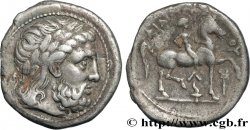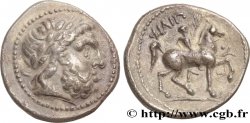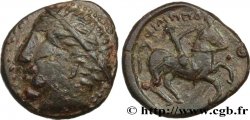bga_228696 - DANUBIAN CELTS - TETRADRACHMS IMITATIONS OF PHILIP II AND HIS SUCCESSORS Tétradrachme à la tête barbue
недоступный.
Товар уже продан в нашем интернет-магазине (2010)
Цена: : 75.00 €
Товар уже продан в нашем интернет-магазине (2010)
Цена: : 75.00 €
Тип Tétradrachme à la tête barbue
Дата: (IIe-Ier siècles avant J.-C.)
Металл: silver
Диаметр: 25 mm
Ориентация осей монеты: 6 h.
Вес: 13,81 g.
Редкость: R2
Комментарии о состоянии
Monnaie très usée avec des types de droit et de revers centrés et à peine identifiables. La tranche est fortment écrasée. Patine grise
Лицевая сторона
Аверс: легенда: ANÉPIGRAPHE.
Аверс: описание: Tête laurée de Zeus à droite ; grènetis.
Обратная сторона
Реверс: Описание: Cavalier au pas à droite, tenant une palme de la main droite ; le cheval lève l'antérieur à droite.
Реверс: легенда: [FILIP - POU].
Комментарий
Si le statère d’or de Philippe II de Macédoine a servi de prototype à de nombreuses imitations gauloises, le tétradrachme n’a pas été imité en Gaule, mais reste principal sujet d’inspiration des monnaies pour les Celtes du Danube (LT. 9697-9767, 9768-9832, 9618-9630, 9870-9886). Les premières imitations furent frappées dans le premier quart du IIIe siècle avant J.-C.
La fabrication des copies serviles, puis des imitations, enfin des frappes celtiques continuèrent pendant plus de deux siècles.
Cet exemplaire semble avoir beaucoup circulé et porte un coup de burin destiné à vérifier la nature du métal. Cette pratique laisse penser que de nombreux faux circulaient à l’époque.
La fabrication des copies serviles, puis des imitations, enfin des frappes celtiques continuèrent pendant plus de deux siècles.
Cet exemplaire semble avoir beaucoup circulé et porte un coup de burin destiné à vérifier la nature du métal. Cette pratique laisse penser que de nombreux faux circulaient à l’époque.








 Cообщить об ошибке
Cообщить об ошибке Распечатать страницу
Распечатать страницу Отправить мой выбор
Отправить мой выбор Задать вопрос
Задать вопрос Consign / sell
Consign / sell
 Информация
Информация



